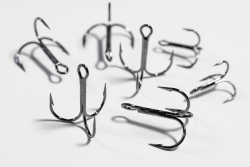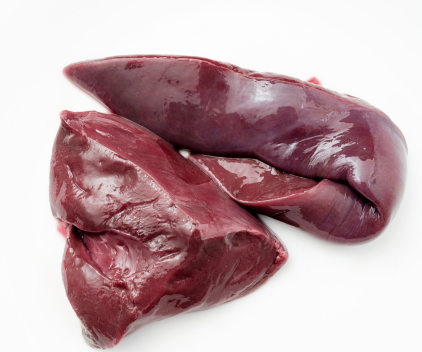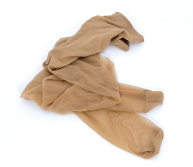Uv Glow Egg Cure Pro Cure for Chicken Liver on
If you ever fish for channel catfish, you have probably used chicken liver. This extremely fragile and soft catfish bait is directly tied to the sport. It is one the best channel catfish baits. The only problem is learning how to keep chicken livers on the hook. Small fish like to pick at it and it likes to rip off on every cast. This can be a huge problem for people who want to cast a rod.
That is pretty much everyone too. Believe it or not, there are some very good and cast proof ways to rig a good liver for catfish. There are many different ways to do it and no one way is right or wrong. The methods may work better or worse depending on where you are in the world. Many love to fish with this smelly concoction but it is way to fragile for any long term use.
For those unaware, the liver of the animal is the organ that filters out and detoxifies metabolites as well as synthesizes proteins. This is a staple food source that can be eaten or used as a fishing bait to catch many species of fish including catfish, striped bass, and other predators.
1. Elastic Bait Thread – The Easiest Way
The most common and popular method of keeping the bait on the hook is to use elastic bait thread. It is basically a very thin rubber band. Elastic bait thread is a very easy to find product and you can purchase it at most tackle stores. You pierce a piece of liver with the hook a few times and then wrap the elastic thread around the meat. This is commonly called a brain rig.
Elastic bait thread is so incredibly cheap to purchase too. Just a few dollars buys hundreds of feet. It does not matter how much you fish. It will take a long time to use up that much elastic thread. Elastic thread does a great job of securing the meat on. To do it properly, put a healthy chunk of meat on the hook point and pierce it a few times. Once you are done, hold the shank.
Start to wrap the thread around the meat loosely and continue to wrap until the meat feels tightly compressed. The last thing you need to do is wrap the thread around the hook shank a few times. Once you have done this, break the thread. You should be left with a very secure presentation. No knots or anything else needed. You can cast as hard as you want too.
2. Tubular Elastic Netting – Most Secure
If you really do not want to lose any bait, the absolute best way that we have found to be the most secure is to use tubular elastic netting. Tubular elastic netting is normally used in the medical industry to prevent bandages and wound dressings from falling off without tape. Brands like Surgitube and Surgilast netting are incredibly good for making sacks that stay on the hook.
This is better than anything else too. All you need to do is cut off a piece, tie a knot, flip it inside out, load the liver inside, and tie another knot. It is very hard to lose anything this way. If the white color bothers you, you can dip it back in the natural fluids to get it to blend in. Tubular elastic netting is the best way to keep chicken liver on the hook because it is easy and effective.
You attach it by piercing the hook through the center of the sack and passing it out of the side. It is not only helpful for casting either. Even when fish are nibbling on it and trying to pick it off, it stays put. This is the stuff you want to try if you want nothing to go to waste. You can always consider rigging up a few sacks before you go out and store them in the food container.
3. Treble Hooks – A Slightly Better Hook
 Treble hooks can hold everything on a little more securely than a traditional circle hook. The key is to know how to use treble hooks correctly. Instead of one point of impact, having the three points increases the surface area that can be used. About thrice as helpful.
Treble hooks can hold everything on a little more securely than a traditional circle hook. The key is to know how to use treble hooks correctly. Instead of one point of impact, having the three points increases the surface area that can be used. About thrice as helpful.
Instead of sticking the hook points in , a better way is to bring the eye of the treble hook up through instead. All three of the hook points act as surface catchers.
The only thing about treble hooks is that they have all the disadvantages of regular hooks. You can still lose bait when casting and when fish are nibbling on it. It works a lot better when you cut small pieces and use them instead. You can almost completely eliminate your problems by cutting a piece that is smaller than the circumference of the inside of the hook. If all three points are outside of the bait itself, you should be golden. It will also increase your hookup ratio.
4. Salmon Egg Netting – A Great Option
If you normally fish for trout, salmon, or steelhead, you likely have some spawn sack netting material laying around for your next trip. Although you would normally use this material for holding cured eggs, it works incredibly well for other soft baits. You can make a very effective liver rig by placing a piece right in the middle, gathering the corners together, twisting, and tying a knot. The material is very useful for creating ways to keep soft baits on the fishing hook.
The mesh is specifically designed to prevent the small eggs from falling through. Spawn sack netting can be obtained from pretty much all retail suppliers with a fishing section. It is not expensive either. Just a few dollars can buy a ton of it. You can rig it by inserting the hook through the top or literally anywhere else. Fish usually hook themselves long before they can manage to rip it off. Salmon egg netting is one of the most secure ways of attaching any meat.
The main thing to be wary of when selecting a salmon egg netting is to be sure that the mesh is tight enough to keep everything inside but not so tight that it prevents any of the blood or iron from entering the water. You want a healthy balance between both characteristics. If the netting is to big, you can lose a lot of bait. If it is to tight, you will not get a scent and flavor trail that leads back to your rod and reel. Be sure to choose salmon egg netting wisely.
5. Drying And Curing The Chicken Liver
If you are willing to stray away from the pungent flavor and odor trail that the fresh stuff offers, you can cure it. You can turn the soft meat into a cured variety that is extremely difficult to tear off. Curing it makes it tougher and it stays on the hook better. You do lose a lot of the flavor and scent unless you use a cure that has its own scents and flavors already inside. There are options.
There are a few different methods you can try that will work well. The first one is to cure the pieces with salt and borax. The salt will dry the bait out and the borax will speed up the process. Borax, or powdered boric acid, is a laundry booster that you add to washing machines for stain removal. Sprinkling the boric acid over the pieces will dry them out and make them tougher.
You can also use commercially made curing formulas. There are certain products on the market that are used to cure soft baits like salmon eggs to prevent them from coming off. Products like ProCure uv glow salmon egg cure have a very nice scent and flavor profile that the catfish love. When you cure it, you take all the moisture out. This leaves you with a bait that will last forever.
This is one of the most secure ways to fish. You will lose very little bait this way. Even when little fish are picking and nibbling at it, they just cannot tear the jerky off of the hook. You can cast as far as you want as many times as you want. If you're willing to put in the time and effort, it is really nice and effective. One bottle can make enough cured bait to last you for months.
6. Egg Loop Knot – No Extra Equipment
If you are a huge fan of not needing to purchase any extra equipment, a great catfish tip is to pin bait straight to the shank of the hook is the egg loop knot. It is just a simple knot that can be tied with a piece of leader. It has a retractable loop on one end that pins the bait on. You do not need any special equipment to tie an egg loop knot and it could not be more simple to tie.
It is basically a hook with a detachable loop on one end that retracts. You cut off a piece of leader and feed it through the front of the eye. A very stiff nylon based leader works best for this. After the leader goes through the front of the eye of the hook, you want to start to wrap it around the hook shank all the way until it gets to the bend. Feed the line through the other side.
Cut the tag end. Run the loop you just created over the hook making sure that the loop end near the knot goes first. Do this five or six times and pull on the line. Tie a loop knot on the end of the line. Now, all you have to do is use the retractable loop to pin the bait to the hook.

7. Bait Saver Hooks – A Metal Bait Keeper
Another great way is to use bait saver hooks. Bait saver hooks are extremely unique and helpful hooks that come equipped with a wire insert. Once you thread the bait on like you would normally, there is a piece of thin and flexible wire that you can tighten down to keep everything from falling off. It is in essence, a metal egg loop knot that is already built right in.
A great thing about bait saver hooks is that they don't just work for liver and other meat. They also work well for other soft choices like salmon eggs, clams, mussels, and many other things. You can purchase bait saver hooks online. You cannot pick them up at a local fishing and tackle store. They cost a bit more than normal hooks but they are very worth it.
Bait saver hooks come in a wide variety of sizes all the way from a size 8 for panfish and perch all the way up to 5/O and 6/O for flathead catfish and muskellunge. They are only sold at one place in the world though. You can purchase them at www.baitsaverhooks.com if you want to get some for yourself. They really are nice hooks. They are extremely sharp and the flexible wire keeper is extremely handy to have on hand. They work regardless of what you fish for.
8. Pantyhose – Odd But It Still Works
Pantyhose is one of those products in catfishing that you either love or hate. There is usually no middle ground when it comes to pantyhose. Many anglers love to use them and others consider it a waste of time. Pantyhose can be used in a certain way to create a very secure ball of bait that works.
If you have a lady in your life and you can get a pair from her, it will be cost free to use. If not, you can always pick some up at a local retailer for very little money. To use it properly, it is pretty easy.
You can cut off a piece and tie a knot in one end. Load your bait and tie another knot. Twisting it until everything becomes tight will only help you before adding your hook. Your left with something that will not come off in casting even if your casting very far. Pantyhose can be effective but it can be annoying having to redo the rig every time you catch a fish.
9. Use Alternative Liver – Beef, Pork, Etc.
 There is no law ever written in any game or fish magazine that binds you to use chicken. We have just sort of always done so because it works. This is not particularly a bad thing though. It will likely remain a part of the sport for many more generations to come.
There is no law ever written in any game or fish magazine that binds you to use chicken. We have just sort of always done so because it works. This is not particularly a bad thing though. It will likely remain a part of the sport for many more generations to come.
There are just as many equally effective if not better options that many of us have yet to try. Believe it or not, every single option of bait out there is not soft. There are many more firmer options available to use.
You can also try to use beef, turkey, rooster, or even pheasant or other game bird liver on your hook. All of these are tougher than chicken and can be used with much the same results. The scent and flavor is not usually the same but the catfish don't seem to care. The availability of these meats at your local grocery store or retail supply outlet may be on the shelf in fewer numbers or not at all. They also tend to cost a little more of an upfront investment.
If you really enjoy the flavor and scent of the original though, you can always give them a dip inside your tub of chicken before you fish. Beef is tougher and is available almost everywhere. Your success may vary depending on what the fish choose to bite on any given day. You will need to try them all out to see what works best. Either may work better or worse.
10. Use Artificial Liver As A Last Resort
Sometimes, you just cannot keep anything on the hook no matter how hard you try. Many of us anglers need to realize that this is just a part of the game. It seems like such a problem when you always have to constantly bait again and again. A simple solution to fix this is to use artificial liver. Artificial liver can be used in place of the fresh stuff to heavily increase the time in the water. Artificial imitations are generally made out of plastic or other composite materials that will stay on near forever. Since they are fake, you do not have to keep them cold to keep them firm.
You also never have to worry about expiration dates or sunlight either. The only disadvantage of using artificial ones is the scent and flavor cloud. Most plastic just does not inject enough scent and flavor in the water to make it worth your while. With this, a great idea is to dip your artificial piece of plastic inside a tub of the real thing. You can also remove all of the meat inside of the container and store them inside with all of the natural liquid to infuse them with the scent.
This results in a highly attractive presentation that is very hard to lose on the cast it and it retains all of the scent and flavor of that real bait has. Fish attractant actually works on artificial baits. Many anglers do not even know that artificial chicken liver exists. Even so, they do. Products like catfish chunks from Berkley do a decent job of staying put but they may not work as well as the real thing. Considering this, using artificial ones should only be considered as a last resort.
It May Be Concluded – Its Not Hard To Secure Liver
Lets face it. When you have extremely soft and fragile baits, learning how to keeping it on the hook is essential. It is always helpful to have much more than one method available for you to try as well when you want to catch catfish. Chicken livers are so soft that they fall off the hook when you cast and almost anything can tear them off. This is why knowing how to keep chicken livers on the hook is crucial to success. You always want to have bait in the water even if soft.
As well all know, bare hooks almost never lead to any fish caught. Instead of putting them away, there are some methods you can try to prevent them from falling off. We encourage everyone to give them all a try and see which one works best for them. They are a great bait that produces consistent results for channel catfish and small blues. They work excellently when used correctly.
What is your favorite way of keeping chicken liver on the hook? If you let us know below in a comment, we can help each other out. What do you think?
Uv Glow Egg Cure Pro Cure for Chicken Liver on
Source: https://onestoptackleshop.com/how-to-keep-chicken-livers-on-the-hook

0 Response to "Uv Glow Egg Cure Pro Cure for Chicken Liver on"
Post a Comment